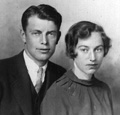|
|
The Piru Mansion.
May 1988.
|
THE DESIGN of the Piru mansion is attributed to the architectural team of Samuel and Joseph Cather Newsom, the most renowned late-Victorian architects in California. It is a typical Newsom rendering of the Queen Anne Victorian style. THE HOUSE WAS BUILT between 1886 and 1890 by David C. Cook, who grew up in Illinois and founded a company bearing his name to publish religious books and Sunday school papers — a company which still is in business as the Cook Publishing Co. of Elgin, Ohio. His health failed when he was a little past 40. Seeking a favorable climate, he selected Ventura County, then beyond the end of rail lines, and purchased the Mexican land grant known as the Rancho Temescal, which included the present town of Piru and several miles of tributary canyons. He laid out the town, built a hotel, the Methodist church down on the corner, and, finally, the mansion. MR. COOK was a devout Methodist, and set out to create both a profitable fruit ranch and a new Garden of Eden. Conforming to fruits mentioned in the Bible, he planted dates, grapes, pomegranates, figs, apricots and olives. The olives and pomegranates have "gone native" and now grow thickly in the town and on the hills around the house. THE RAILROAD was completed about the time the house was under construction, which allowed for doors, windows, lumber and tile to be shipped in, as well as for dried fruit to be sent to market. THE MANSION was equipped with gas, since there were natural gas wells on the ranch, but it had no electricity or running water. The small circular structure uphill from the main house is the three-hole outhouse, which was used until the turn of the century when Mr. Cook, his health restored, departed for the East and left the mansion to his son. His son introduced two bathrooms, one upstairs and one down, and the Warring family, who bought the house in 1912, added a third bath in the 1940s. THE PRESENT OWNERS, Mr. and Mrs. Scott Newhall, bought the mansion from the Warring estate in 1968. They went slowly about installing wainscoting, papering, and finally were modernizing the kitchen and painting the exterior in 1980-81. In February 1981 a spark from a painter's torch apparently escaped under the eaves to the attic, and the mansion burned to the ground. By the time the debris (86 dumpsters full of remains) was carted away, nothing remained but the floor tile, the stone work, the lower two-thirds of the tower, and two chimneys. GUIDED BY PHOTOGRAPHS contributed by many visitors to the mansion, and by the expert knowledge of people who had helped maintain and restore it over the years, the Newhalls began reconstruction. COMPLETION of the rebuilt mansion took two and one-half years. The materials, including all-redwood exterior siding, the stained glass, the tile patterns in the floors, and the carved wood of the original have been faithfully reproduced. Thanks to skilled and imaginative artisans, some additional design elements (like the library ceiling) have been added. One of the additions is the bird, carved from redwood, atop the small tower on the west front, where before the fire was an egg-shaped finial. The bird is a symbolic phoenix rising from the ashes. WITH RARE EXCEPTIONS, the furniture is antique, as are the chandeliers. The design of the kitchen is new, as are the bathrooms — one for each bedroom. The fire made it possible to install modern heating and air conditioning, so that the owners were able to combine the best of Victorian with the best of modern living. The mansion is a private home. It is open for viewing only on advertised occasions. 5/88
LW3029: pdf of original brochure, collection of Connie Worden-Roberts. Download original images here.
|
SEE ALSO:
Oral History 1988/89
Family Photos x7
World Cruise 1936
Scott, Skip, Tony, Jon 1944
Chronicle x3
Buys Signal 1963
12/23/1965
Anguilla 1967
Scott in England 1969
Eppleton Hall 1970
Pinback: Scott for Mayor 1971
Scott for Mayor 1971
Tony Newhall & Clarion Publisher Jackie Storinsky 1971
Signal Ingot ~1973
Signal 1980s
Silver Spur 1991
Signal Special Edition Upon Scott's Death 1992
Historical Society 2/1993
Video: Ruth Interview 2000
• Ruth Obituary 1
Ruth Tribute 1/2004
|
The site owner makes no assertions as to ownership of any original copyrights to digitized images. However, these images are intended for Personal or Research use only. Any other kind of use, including but not limited to commercial or scholarly publication in any medium or format, public exhibition, or use online or in a web site, may be subject to additional restrictions including but not limited to the copyrights held by parties other than the site owner. USERS ARE SOLELY RESPONSIBLE for determining the existence of such rights and for obtaining any permissions and/or paying associated fees necessary for the proposed use.



















